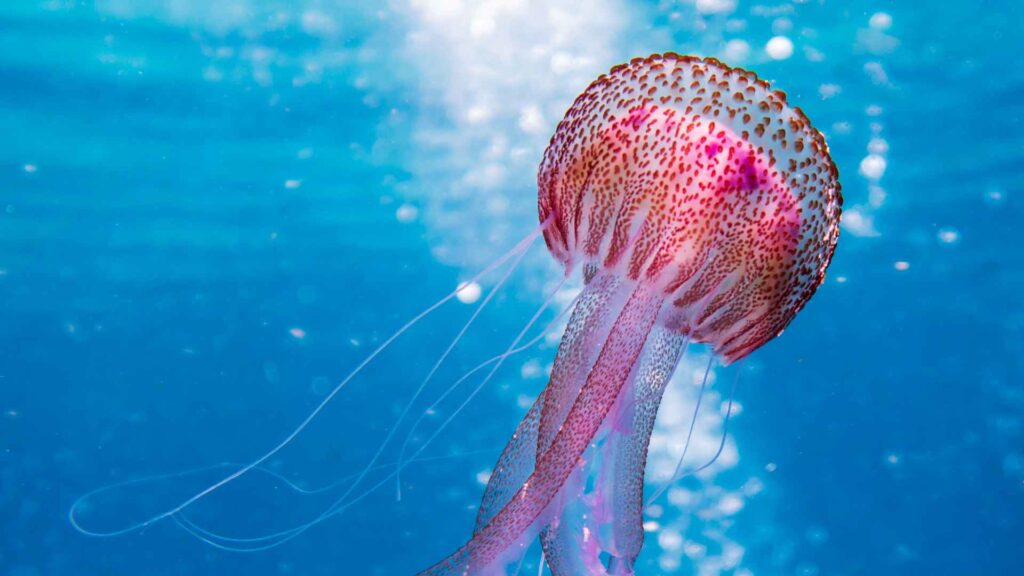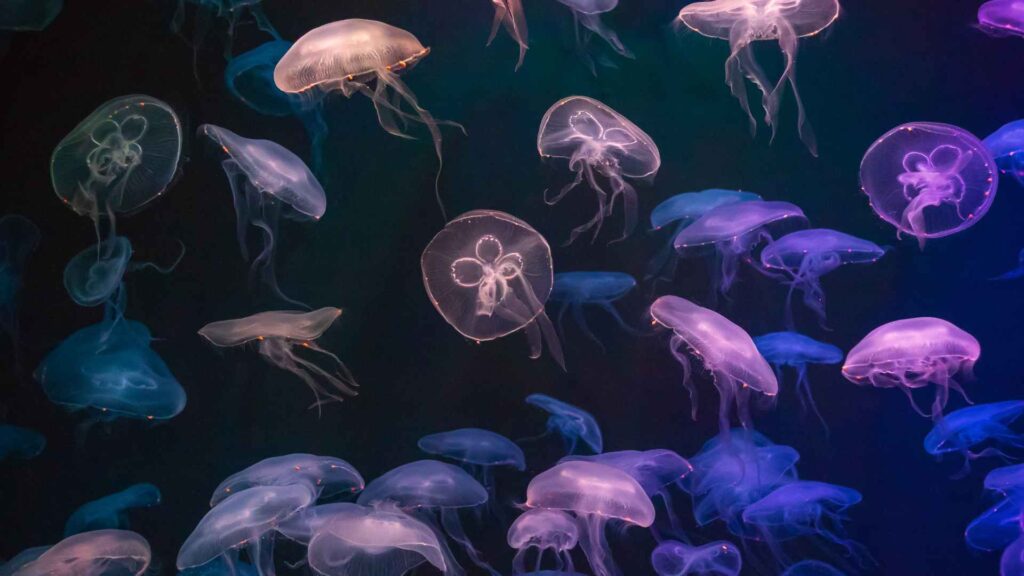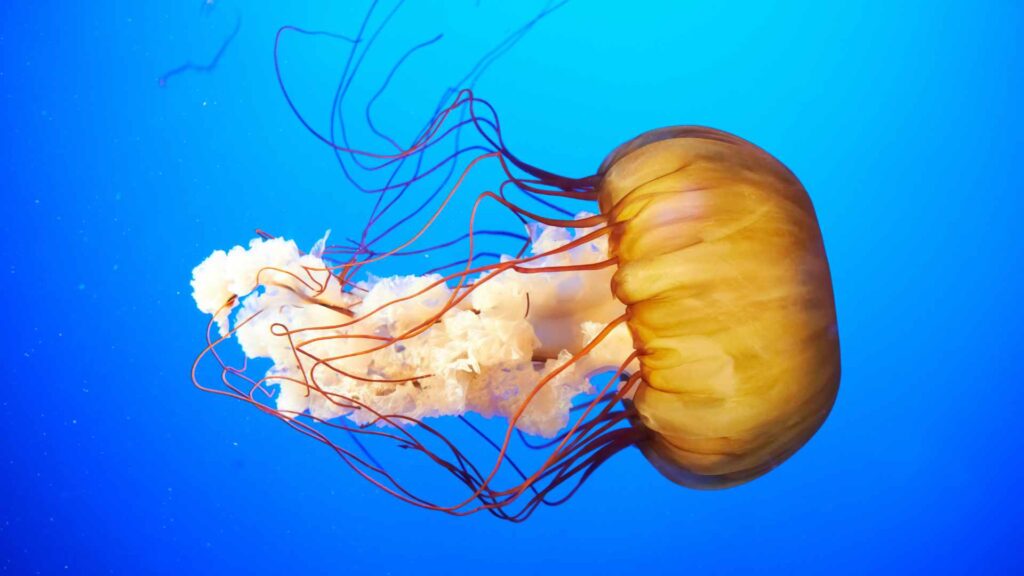Jellyfish, the captivating drifters of the ocean, have existed for over 500 million years.
From their fascinating anatomy to their survival in extreme environments, jellyfish are nothing short of miraculous.
Here’s a comprehensive guide packed with 145 fun facts about jellyfish, guaranteed to leave you amazed and eager to learn more about these aquatic wonders.
Anatomy and Physical Characteristics of Jellyfish
- Jellyfish are 95% water, which is why they appear translucent.
- They lack brains, hearts, and lungs but survive by a decentralized nerve net.
- Jellyfish have stinging cells called nematocysts to paralyze prey.
- Some jellyfish are bioluminescent, producing light to deter predators.
- Their umbrella-shaped bodies are called bells and are vital for movement.
- Jellyfish can detect light but don’t have actual eyes.
- The tentacles of the lion’s mane jellyfish can grow over 120 feet long.
- Despite having no skeleton, they are classified as invertebrates.
- Jellyfish don’t actively swim but use currents for most of their movement.
- Their translucent bodies help them camouflage in the water.
- They absorb oxygen directly through their skin.
- Moon jellyfish have a flower-shaped design due to their gonads.
- Box jellyfish have up to 24 eyes and are surprisingly agile swimmers.
- They don’t have a digestive system; their mouths double as an anus.
- Jellyfish are capable of shrinking during food shortages to conserve energy.

Habitat and Distribution
- Jellyfish are found in every ocean, from surface waters to deep-sea trenches.
- They thrive in both saltwater and freshwater ecosystems.
- Polar regions host jellyfish that can survive frigid waters.
- Some species of jellyfish are known to inhabit brackish water.
- The Arctic Lion’s Mane jellyfish is adapted to freezing temperatures.
- Jellyfish blooms occur in nutrient-rich waters with low oxygen levels.
- Mangrove forests often house unique jellyfish species.
- The Pacific Ocean is home to the deadly box jellyfish.
- Freshwater jellyfish, such as Craspedacusta sowerbii, are rare but widespread.
- Jellyfish populations tend to increase in overfished areas due to reduced competition.
- Coastal lagoons and estuaries are popular habitats for certain species.
- Jellyfish are most commonly found in warm, tropical oceans.
- They drift with ocean currents, often traveling thousands of miles.
- Deep-sea jellyfish, such as Atolla, emit light to attract prey.
- Jellyfish can survive in hypoxic (low oxygen) environments where other species cannot.
Feeding Habits and Diet
- Jellyfish are carnivorous, feeding on plankton, small fish, and crustaceans.
- They use their tentacles to capture and immobilize prey.
- Some jellyfish can eat other jellyfish!
- Box jellyfish are active hunters and use vision to track prey.
- Moon jellyfish consume zooplankton and microscopic organisms.
- Upside-down jellyfish form a symbiotic relationship with algae, sharing nutrients.
- Jellyfish digest food quickly to stay buoyant.
- They rely on passive feeding, letting food drift into their tentacles.
- Comb jellies (not true jellyfish) use cilia to create feeding currents.
- Jellyfish can consume large quantities of plankton during blooms.
- Their nematocysts inject venom to stun prey instantly.
- Jellyfish may starve during prolonged periods of food scarcity.
- Giant jellyfish can eat larger fish due to their size.
- Predatory species like the sea wasp actively chase their food.
- Jellyfish are opportunistic feeders, adjusting their diet based on availability.

Reproduction and Life Cycle
- Jellyfish have a complex life cycle with both sexual and asexual stages.
- The medusa stage is the adult, free-floating jellyfish form.
- Jellyfish reproduce by releasing eggs and sperm into the water.
- Larvae settle on the seafloor and develop into polyps.
- Polyps can reproduce asexually, budding off young medusae.
- The immortal jellyfish, Turritopsis dohrnii, can revert to the polyp stage indefinitely.
- Jellyfish larvae, called planulae, are tiny and free-swimming.
- Many species have a seasonal breeding cycle.
- Jellyfish polyps can remain dormant for years, waiting for favorable conditions.
- Some species exhibit mass spawning, with thousands releasing gametes simultaneously.
- Temperature and light influence jellyfish reproduction.
- Jellyfish exhibit external fertilization, with eggs developing outside the body.
- Not all jellyfish have the ability to revert stages; this is unique to Turritopsis.
- Some jellyfish species reproduce solely by cloning themselves.
- Jellyfish blooms often coincide with breeding seasons.
Interactions with Humans
- Box jellyfish stings are among the most venomous, potentially fatal to humans.
- Vinegar is a first-aid remedy for certain jellyfish stings.
- Jellyfish blooms can disrupt fishing and tourism industries.
- In some countries, jellyfish are considered a delicacy.
- Certain jellyfish-derived compounds are used in medical research.
- The glow of bioluminescent jellyfish has inspired lighting technology.
- Jellyfish stings can cause severe allergic reactions in some individuals.
- Anti-jellyfish nets are used at popular swimming beaches.
- Jellyfish are sometimes kept in specialized aquariums for their beauty.
- Dried jellyfish are sold as souvenirs in some coastal areas.
- Overfishing indirectly contributes to jellyfish population growth.
- Coastal power plants sometimes shut down due to jellyfish clogging intake pipes.
- Jellyfish mucus is being studied for use in anti-aging skincare.
- Some species’ venom may offer insights into new painkillers.
- Tourists are advised to avoid swimming in jellyfish-infested waters.
Unique and Rare Jellyfish
- The Irukandji jellyfish is tiny but extremely venomous.
- Deepstaria jellyfish resemble translucent, flowing bags.
- Comb jellies are not true jellyfish but are often mistaken for them.
- Blue blubber jellyfish are common in Australian waters.
- The crystal jellyfish is famous for its glowing proteins.
- Spotted lagoon jellyfish live symbiotically with algae.
- Cannonball jellyfish are popular in Asian cuisine.
- Nomura’s jellyfish is one of the largest species, weighing up to 440 pounds.
- The fried egg jellyfish has a yellow center resembling a yolk.
- Black sea nettles are rare and found along the California coast.
- The pink meanie jellyfish preys on other jellyfish species.
- Flower hat jellyfish are small but beautifully patterned.
- The mauve stinger jellyfish is known for its vibrant purple hue.
- The immortal jellyfish can reverse aging.
- Atolla jellyfish are often spotted in deep-sea documentaries.

Bonus Facts About Jellyfish
- Jellyfish have existed longer than dinosaurs.
- They have no bones, which is why fossil records are rare.
- Jellyfish blooms can cover hundreds of miles of ocean.
- Some species have tentacles 10,000 times more sensitive than human skin.
- Their stings are used defensively and offensively.
- Jellyfish lights inspired LED technology.
- Not all jellyfish sting; some are harmless to humans.
- Nomura’s jellyfish can grow larger than a refrigerator.
- They are part of traditional medicine in some cultures.
- Jellyfish are more efficient swimmers than most fish.
- Giant jellyfish are considered apex predators of plankton blooms.
- They play a key role in marine food chains.
- Jellyfish mucus has potential applications in water purification.
- Fossilized jellyfish date back over 500 million years.
- Bioluminescent species light up during storms to confuse predators.
- Some species thrive in polluted environments.
- Jellyfish are eaten by leatherback turtles and sunfish.
- Certain jellyfish glow due to symbiotic bacteria.
- They can regenerate lost tentacles.
- Jellyfish populations are expanding due to global warming.
- Some jellyfish species are transparent, making them nearly invisible to predators.
- Jellyfish play a role in nutrient recycling by breaking down organic matter.
- They have no blood or circulatory system, relying on diffusion for transport.
- The tentacles of jellyfish can regenerate if damaged or lost.
- Jellyfish are often mistaken for plastic bags, a common threat to marine life.
- Their life span varies greatly, with some living only hours and others for years.
- In Japan, jellyfish are used to make ice cream with a unique texture.
- Their gelatinous bodies are largely protein-based, making them low-calorie.
- The immortal jellyfish is being studied for insights into aging and medicine.
- Jellyfish contain collagen, a key ingredient in many beauty products.
- Some species are capable of cloning themselves if cut into pieces.
- Jellyfish stings can trigger heart failure in extreme cases.
- They can survive in anoxic environments where oxygen is nearly absent.
- Jellyfish mucus is being researched for its potential use in biofuel.
- They can thrive in environments with low biodiversity, taking over ecosystems.
- Jellyfish lack pain receptors, so they cannot feel physical pain.
- Their venom varies widely, with some species posing no threat to humans.
- In Chinese culture, jellyfish symbolize longevity and regeneration.
- Jellyfish-inspired robots are being developed for underwater exploration.
- The box jellyfish can swim up to 4 knots, faster than most jellyfish species.
- Jellyfish DNA has been inserted into other organisms to create bioluminescent traits.
- Some deep-sea jellyfish can emit a blue or red glow to ward off predators.
- They are considered an environmental indicator, signaling changes in ocean health.
- The Portuguese man o’ war is often mistaken for a jellyfish but is a siphonophore.
- Jellyfish help balance marine ecosystems by preying on overpopulated species.
- They can adjust their buoyancy by altering the water content in their bells.
- Some jellyfish species can store energy for long periods, surviving without food.
- Jellyfish blooms have been known to clog fishing nets and ship engines.
- They are among the few creatures that can survive near undersea volcanoes.
- Researchers use jellyfish venom to develop treatments for hypertension and cancer.
Jellyfish are truly awe-inspiring creatures with remarkable traits and adaptations.
From their ancient lineage to their incredible bioluminescence and survival skills, these marine marvels continue to amaze researchers and nature enthusiasts alike.
